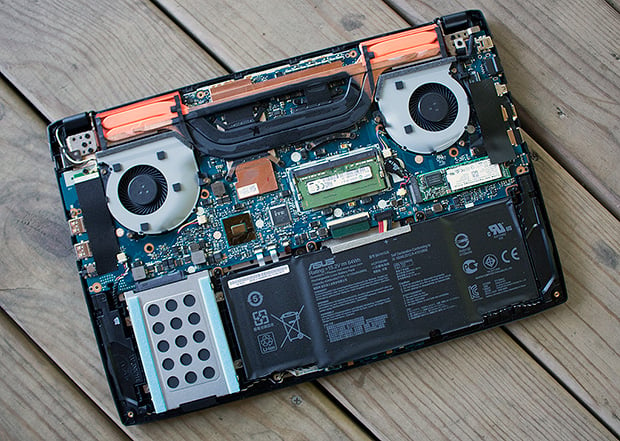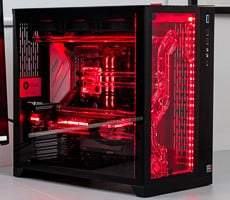ASUS ROG Strix GL502VT-GS74 Gaming Laptop Review
Instead of brushed aluminum, as appears to be the case, the lid is made from a thin sheet of pliable plastic. And if you run your fingers along the Strix branding, it quickly becomes apparent that those aren't orange LEDs shining through or even painted parts, but stickers applied to indentations in the lid. We'd be more forgiving of the plastic construction and adhesives on a sub-$1,000 laptop, but this is an otherwise well-equipped system with an uptown MSRP.

Looking beyond the physical makeup of the housing, the tenants of this machine help justify its property value. It starts with the 15.6-inch IPS display (non-touch). This particular model features a Full HD 1080p (1920x1080) resolution, but in time ASUS plans to offer a 4K Ultra HD option. As it stands, the display offers good viewing angles (160 degrees) with crisp colors and plenty of brightness—we measured 350 lux on our brightness meter—though it lacks the G-Sync support as found on the GL502VT-DS71 ($1,699) and GL502VY-DS74 ($1,899).
We didn't feel the need to tweak the display during testing, though you can switch between profiles or make manual adjustments to the color temperature through the included Splended utility. One of the profiles is called Eye Care, which you can also enable and disable by double-clicking the Eye Care icon on the desktop. What this does is dim the display and reduce blue light to prevent eye fatigue and prevent Computer Vision Syndrome (CVS) symptoms, such as headaches and burning eyes.

For gaming in the dark there's a red LED backlight that you can adjust with three different brightness levels or disable altogether. ASUS also gave the all-important WASD key caps a splash of color, presumably to add some street cred to what's classified as a gaming laptop and to make sure you're not fumbling around for the right keys in the heat of battle. The custom font used on the key caps also adds a bit of gamer bling to the GL502VT-DS74.
There are no standalone macro keys to be found, though you can disable the Windows key to prevent accidentally hopping out of the action mid-battle. You'll also find a bunch of media controls and other shortcuts serving as secondary controls to the Function keys.
The plastic trackpad with gesture support sits slightly off center to the left and is serviceable, though obviously you'll want to use a mouse for any serious gaming. A thin orange line that borders the trackpad adds to the aesthetic appeal.

Ports (Left)

Ports (Right)
Over on the left side is the DC-in power port, GbE LAN, a single mini DisplayPort, HDMI output, a USB 3.0 port, and a USB Type-C port that operates at the USB 3.1 Gen1 specification (5Gbps, same as USB 3.0). A third USB 3.0 port would have been a welcome inclusion, but at least with two of them you can plug in an external keyboard and mouse.

Once removed, you have easy access to storage, a single 8GB SO-DIMM module, and a few other parts. We're not sure if ASUS soldered more RAM onto the motherboard somewhere or installed a second 8GB stick hidden away (this model ships with 16GB of DDR4-2133 RAM), but the other 8GB is somewhere and the system does run in dual-channel mode.
As for the battery, it's replaceable but not what we would consider removable, at least not in the sense that you'll carry around a spare battery pack to plug into the back. There are four screws that hold the battery in place, plus a cable that protrudes out and plugs into the motherboard. The good news here is that it's easy to access and isn't held down with adhesive.







